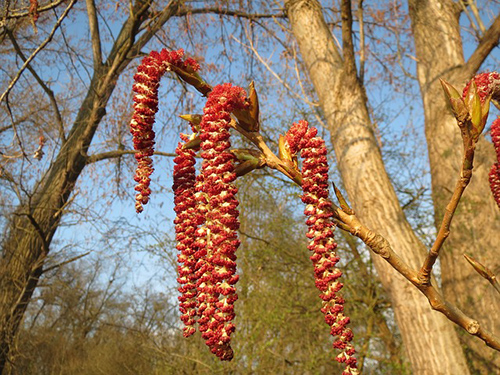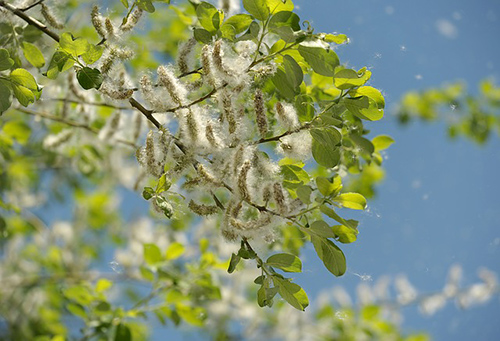Contents
The tall black poplar tree has a long, straight appearance. It is mainly found near rivers and lakes. This is a long-living tree (it can reach 300 years of age), though it has been attacked, especially in Europe, by fungi, insects, and parasite plants such as mistletoe in the last decades. Therefore, black poplar forests and plantations are being decimated. Trees also become ill. However, despite that, it preserves its medicinal properties, known since ancient times.

Healing Properties and Indications
The leaf buds of the black poplar tree, and in a lesser proportion, the bark of the branches contain essential oil, flavonic and phenolic glycosides (salicin and populin), and tannin. Its properties are as follows:
- Sudorific, febrifuge, and diuretic: It provokes perspiration, decreases fever, and increases urine production. This is especially helpful for treating fever diseases and whenever a depurative effect on the body is required.
- Anti-inflammatory and antirheumatic: When used internally, it is recommended for rheumatic attacks, polyarthritis (inflammation of several joints), and rheumatic aches in general.
- Balsamic and expectorant: It is administered for acute and chronic bronchitis and all types of bronchial catarrh. It reduces the inflammation of the bronchial mucosa and promotes a thinner mucus, which is thus more quickly eliminated.
- Charcoal: The black poplar wood is highly adequate for obtaining charcoal.
- Externally applied, populeous ointment is a proven effective remedy for hemorrhoids. It has been present in European pharmacies for three centuries and is still an excellent treatment for congestion and hemorrhoid pain. Moreover, it is vulnerary; that is, it heals skin wounds and bruises. It is also applied, though its effectiveness has not been proven for hair loss.
Poplar Tree Scientific Facts
- Other names: Poplar
- French: Peuplier noir.
- Spanish: Alamo negro, chopo negro.
- Environment: The black poplar tree is common in humid forests and cultivated in Europe and America.
- Description: A deciduous tree of the Salicaceae family, it can grow up to 30 m high and has dark green leaves that are petioled, slightly toothed, and triangle-shaped. It is a dioic species: some leaves have male flowers, and others have female flowers.
- Parts of the plant used medicinally: The young buds in Spring, the bark, and the wood.
How to use Black Poplar
- Decoction with 30-40 g of young buds of black poplar per liter of water, boiling for 10 minutes. Pieces of bark can also be added to this decoction. Strain, sweeten with honey, and drink three to four cups daily.
- Populous ointment: Prepared with 50 g of young buds of black poplar, mashed, and mixed with 150 g of fat (Vaseline, butter, etc.). Heat in a double boiler for 2-3 hours, then strain through a fine gauze. Apply three or four times daily to the affected area.

Other Poplar Trees
There are some 30 species of poplar trees. They all have similar medicinal properties, though with effects of variable intensity.
- White poplar (Populus alba L.), whose leaves are silver on the underside, unlike those of the black poplar, which are dark green.
- Shaking poplar (Populus tremula L.) has lighter-colored leaves on the underside and a long petiole that allows it to be wind-shaken.
- American poplar trees (Populus balsamiferous L. and Populus candicans L.) are native to America. They have young buds from which the Gilead balm is obtained. The Gilead balm’s preparation, properties, and applications are the same as those of the populous ointment.
Black Poplar Tree Charcoal
Charcoal made from the finely ground black poplar tree wood is a powerful absorbent of toxins in the digestive tract. The most critical applications of charcoal are the following:

- Antidote for poisoning with plants or substances.
- It is antidiarrheic and antitoxic for gastroenteritis, colitis, intestinal fermentation, and putrefaction, which cause flatulent or fetid dyspepsia.
- Toothpaste: When brushing teeth with ground charcoal, teeth become white, and gum inflammation reduces. Charcoal also eliminates plaque and food particles that accumulate on teeth and under the gums.
Though not an herb, charcoal is still invaluable in several ways. It is pure carbon and can neutralize twenty-nine of thirty of the most dangerous poisons by absorbing them (not absorbing, but binding). Charcoal is primarily obtained from hardwood and is produced by slow combustion in the relative absence of oxygen.
In an emergency, and you do not have any charcoal on hand, you can burn a piece of hardwood and chip or scrape the charcoal from the charred wood. After moistening it with water, put it through a food grinder. Commercial sources are mainly made from coconut shells. (Charcoal briquettes or burnt toast are not charcoal). Treatment with superheated steam can produce “activated” charcoal, capable of a much more significant adsorptive effect. This is because more of the charcoal has been exposed.
Charcoal has a great surface area because it has millions of micropores with surface areas ranging from four hundred to over 1800 square meters per gram. There are fifty million charcoal particles in one pound. Charcoal cannot absorb all poisons, but it can bind with and thus neutralize a lot of them. Here are a few of the poisonous items it can absorb:
| 1. Industrial toxins | 2. DDT |
| 3. Dieldrin | 4. Strychnine |
| 5. Malathion | 6. Parathion |
| 7. Medical drugs | 8. Aspirin |
| 9. Barbituates | 10. Cocaine |
| 11. Opium | 12. Nicotine |
| 13. Morphine | 14. Penicillin |
| 15. Sulfas | 16. Inorganic chemicals |
| 17. Mercury | 18. Phosphorus |
| 19. Chlorine | 20. Iron |
| 21. Lead | 22. Silver |
In any acute poisoning, the best thing to do is induce vomiting, followed by a hefty dose of activated charcoal diluted in water to make most substances harmless. If injected with any toxin, you’ll need about 30 to 60 grams (½ cups) of charcoal combined in water, which should be taken immediately.
Charcoal is also helpful in treating intestinal gas (about a spoonful in half a glass of water, followed by another glass of water). It is also advantageous for those suffering from diarrhea. For people with unusual chronic bowel inflammations and colitis, a slurry solution made from charcoal can be made by stirring activated powdered charcoal into water. Then use only the cloudy solution, which results after the liquid has been set for a couple of hours.
This “slurry enema” will reduce inflammation locally, giving considerable relief. Externally, you can use it as a poultice on wounds, skin infections, and above-inflamed body areas.
Powder: Take ½ to 1 ½ teaspoon in ½ to one cup of water—swallowed, spread onto a poultice, or taken as a slurry. Tablets: Four to eight chewed in the mouth and then eaten.
DISCLAIMER: All content on this website is presented solely for educational and informational objectives. Do not rely on the information provided as a replacement for advice, diagnosis, or treatment from a qualified medical expert. If you are pregnant, nursing, or have any preexisting medical concerns, talk to your doctor before using any herbal or natural medicines.
REFERENCES
- George D. Pamplona-Roger, M.D. “Encyclopedia of Medicinal Plants.” George D. Pamplona-Roger, M.D. Encyclopedia of Medicinal Plants. Ed. Francesc X. Gelabert. vols. 2 San Fernando de Henares: Editorial Safeliz, 2000. 760, 761. Print. [black poplar tree]
- Vance Ferrell Harold M. Cherne, M.D. The Natural Remedies Encyclopedia [Book]. – Altamont, TN: Harvestime Books, 2010. – Vol. Seventh Edition: 7: pp. 152.
- WebMD Poplar: https://www.webmd.com/vitamins/ai/ingredientmono-245/poplar
- Symbolism and Benefits of the Black Poplar: https://greg.app/black-poplar-benefits/
